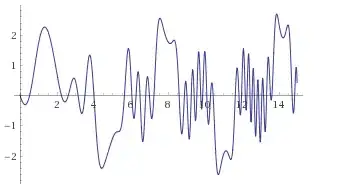I am talking about finding a simple, exact, non-trivial solution such as $x = \pi/6$. Of course, $x=0$ or $x=\pi$ are trivial solutions. I created this equation with its exact solution in mind beforehand, so that's how I know the solution, but if you don't know the solution to begin with, how easy is it to find it, other than using trial and error? Is it an exam question that you could ask to high school students? Another similar equation is $\sin x + \sin(2x \sin x) = 1$ and it also has $x=\pi/6$ as a solution. Interestingly, Wolfram Alpha can not find the exact solution, only an approximation (with as many correct digits as you want). See plot of $\sin x + \sin(2x \sin x) - \sin 3x$, below.
-
3Yes, it is! The problem is that you have "x" both inside and outside a transcendental function. If I really had to solve such a problem I would probably write sine and cosine in terms of exponentials and try to use "Lambert's w function". – user247327 Apr 08 '19 at 13:59
-
For high school students writing $sin(A)+sin(B)$ or $sin(A)-sin(B)$ as a product, followed by a factorization should be about right. That idea is not helpful here so I would say no, not suitable. – Paul Apr 08 '19 at 14:01
-
It is not easy even if you know that: . $ \sin(3x)=3\cdot \sin x -4\cdot \sin^3 x. $Source:https://math.stackexchange.com/questions/97654/is-sin3-x-frac34-sin-x-frac14-sin-3x – NoChance Apr 08 '19 at 14:41
-
You will have a hard time finding anything with physical meaning with the form $\sin(\ldots \sin(x))$. Sine is a function that converts angles to ratios and chaining them like this makes no physical sense. – John Alexiou Apr 08 '19 at 15:13
-
1" Is it an exam question that you could ask to high school students?" You should never ask a student a question that you yourself can't answer! – fleablood Apr 08 '19 at 16:14
2 Answers
Just kidding : if you expect analytical solutions for such monsters, stop dreaming !
Now, being serious : take into account that the simple $x=\cos(x)$ does not shw analytical solutions and needs to be solved using numerical methods.
Consider that you look for the zero's of $$f(x)=\sin (x) + \sin(2x \sin (x)) -\sin (3x)$$ Plot the function and, visually, locate where (more or less) is the root you want (there is an infinite number of solutions). Call this value $x_0$ and start using Newton method which will update the guess according to $$x_{k+1}=x_k-\frac{f(x_k)}{f'(x_k)}$$
For example, there is root "around" $x=2$. Let us try to get the following iterates $$\left( \begin{array}{cc} k & x_k \\ 0 & 2.0000000000000000000 \\ 1 & 2.2077878077914573503 \\ 2 & 2.2372992747296569378 \\ 3 & 2.2389331854770425722 \\ 4 & 2.2389386369537428867 \\ 5 & 2.2389386370146724403 \end{array} \right)$$ which is the solution for twenty significant figures.
- 260,315
-
This equation has an infinite number of trivial solutions ($x = k\pi$ where $k$ is any positive or negative integer), an infinite number of non-trivial solutions that can not be expressed analytically (for instance the one you found), and then one analytical, non-trivial solution, $x = \pi/6$. – Vincent Granville Apr 08 '19 at 15:00
-
Is the $\pi/6$ solution really analytical? What analytical methods are used to identify it? Just guessing is not an analytical method. – Oscar Lanzi Apr 08 '19 at 15:05
-
I did not use an analytical method to find the solution. It is part of a general type of equations, namely $f(x) + f(x f(x)) = 2 f(1)$ where one of the solutions must of course also be solution of $f(x) = 1$. In this case, $f(x) = 2\sin x$. – Vincent Granville Apr 08 '19 at 15:22
-
1@VincentGranville - there is more than one analytical solution. Check out $x=\tfrac{5}{6}\pi$ as well as $x=-\tfrac{7}{6}\pi$. These are generated by solving $$\sin(x) = \sin(2 x \sin(x))$$ – John Alexiou Apr 08 '19 at 20:44
The rule here is that anything that appears both inside and outside a transcendental function makes it impossible to solve analytically. Examples are
$$ x - 2 \sin(x) = 0 $$ $$ x \cos(x)+\sin(x) = 1 $$
But you can convert any equation that has sines and cosines of $x$ into a polynomial using the tan-half-angle substitution $t = \tan \left( \frac{x}{2} \right)$.
Example, solve:
$$ 3 \sin(x)-\cos(x) = \sqrt{6} $$
Use the substitution $x = 2 \tan^{-1}(t)$ in the expression above which yields $$ \begin{aligned} \sin(x) & = \frac{2 t}{1+t^2} \\ \cos(x) & = \frac{1-t^2}{1+t^2} \end{aligned} $$
Now solve the expression below in terms of $t$
$$ 3 \frac{2 t}{1+t^2} -\frac{1-t^2}{1+t^2} = \sqrt{6} $$
$$ t = \begin{cases} 1+\sqrt{6} & \text{1st solution} \\ \tfrac{1+\sqrt{6}}{5} & \text{2nd solution} \end{cases} $$
with the solution in terms of $x$
$$ x = \begin{cases} 2 \tan^{-1}\left(1+\sqrt{6}\right) = 2.57727... & \text{1st solution} \\ 2 \tan^{-1}\left( \frac{1+\sqrt{6}}{5}\right) = 1.20783... & \text{2nd solution} \end{cases} $$
Confirmation:
$$ \left. 3 \sin(2.57727)-\cos(2.57727) = \sqrt{6} \phantom{\matrix{\\ \\}} \right\} 2.4494897...=2.4494897... $$
and
$$ \left. 3 \sin(1.20783)-\cos(1.20783) = \sqrt{6} \phantom{\matrix{\\ \\}} \right\} 2.4494897...=2.4494897... $$
- 13,816
-
"The rule here is that anything that appears both inside and outside a transcendental function makes it impossible to solve analytically." True in general, but this one is an exception. – Vincent Granville Apr 08 '19 at 16:37
-
@VincentGranville - do tell. Don't leave us hanging. What is the exception? – John Alexiou Apr 08 '19 at 18:02
-
Solution is $\pi/6$. I posted more details in one of my articles, at https://dsc.news/2LFF9xS – Vincent Granville Apr 08 '19 at 18:58
-
@VincentGranville - I don't see how you go from $\sin(3 x)$ to $2 f(1)$ for the RHS. – John Alexiou Apr 08 '19 at 20:34
-
Yes, there was one extra step. Since $2 = 2 \cdot 1$, and since $\sin 3x = \sin(\pi/2) = 1$, I replace $1$ by $\sin 3x$. – Vincent Granville Apr 08 '19 at 22:27
